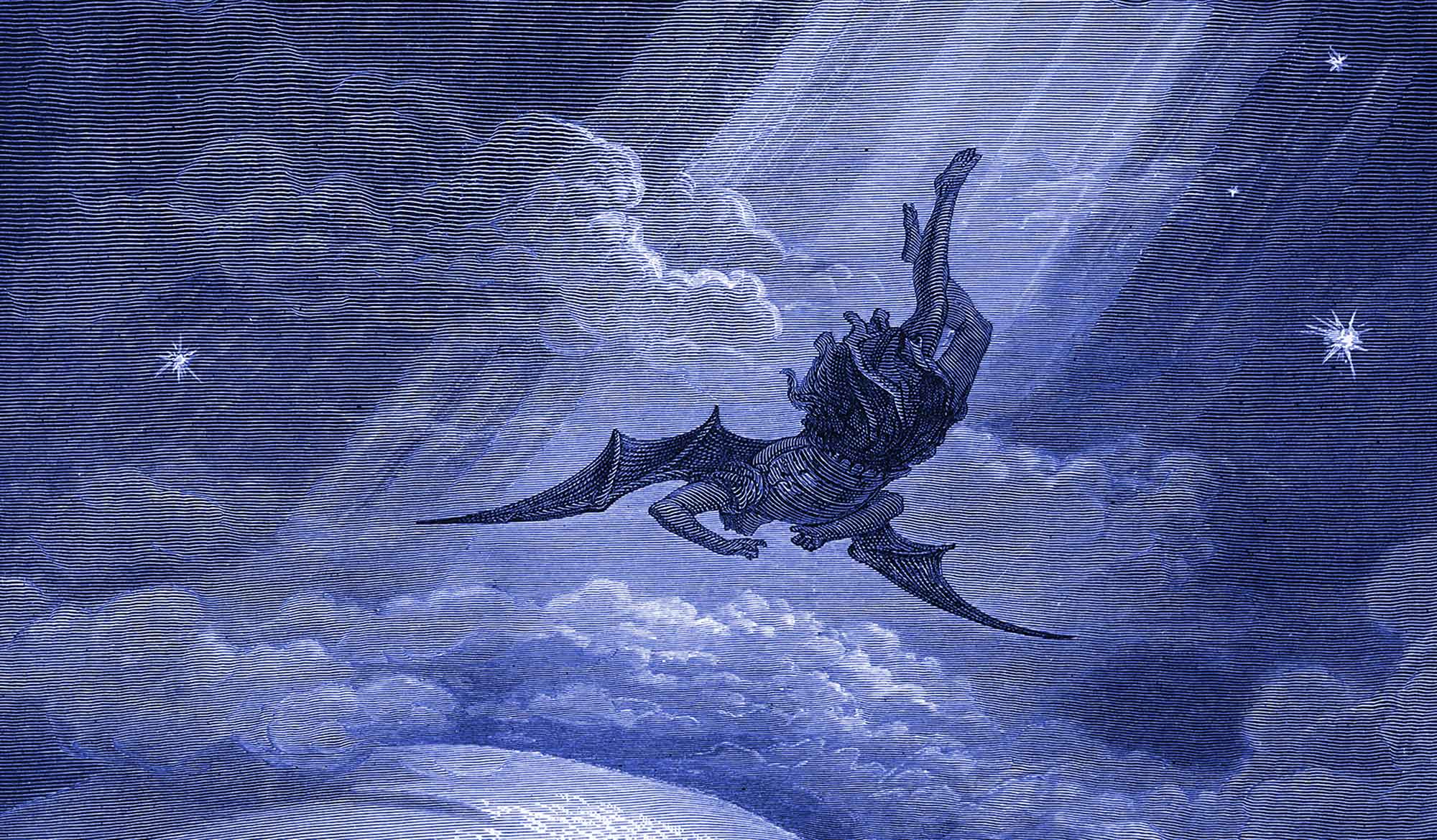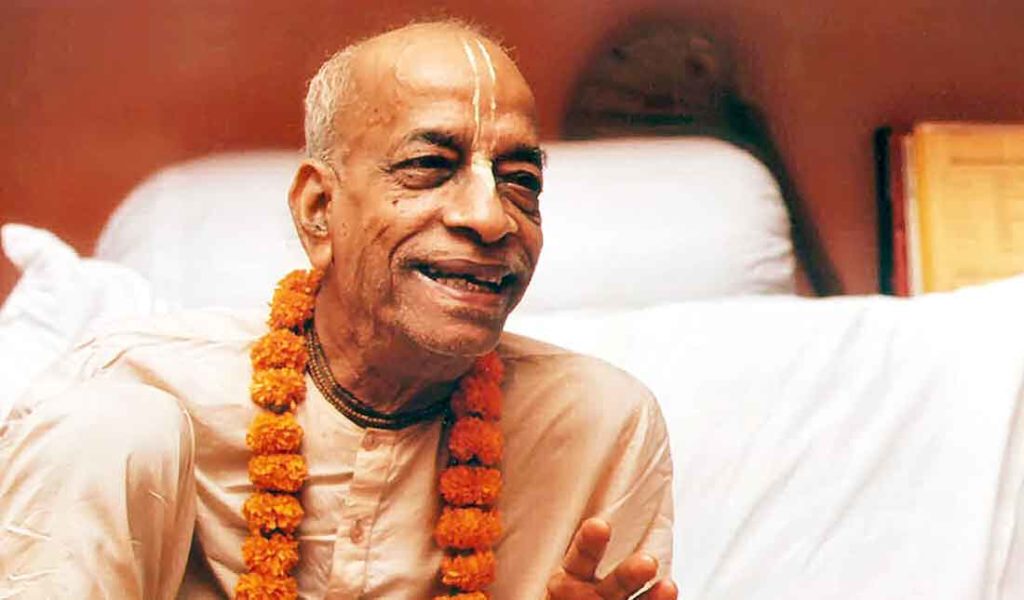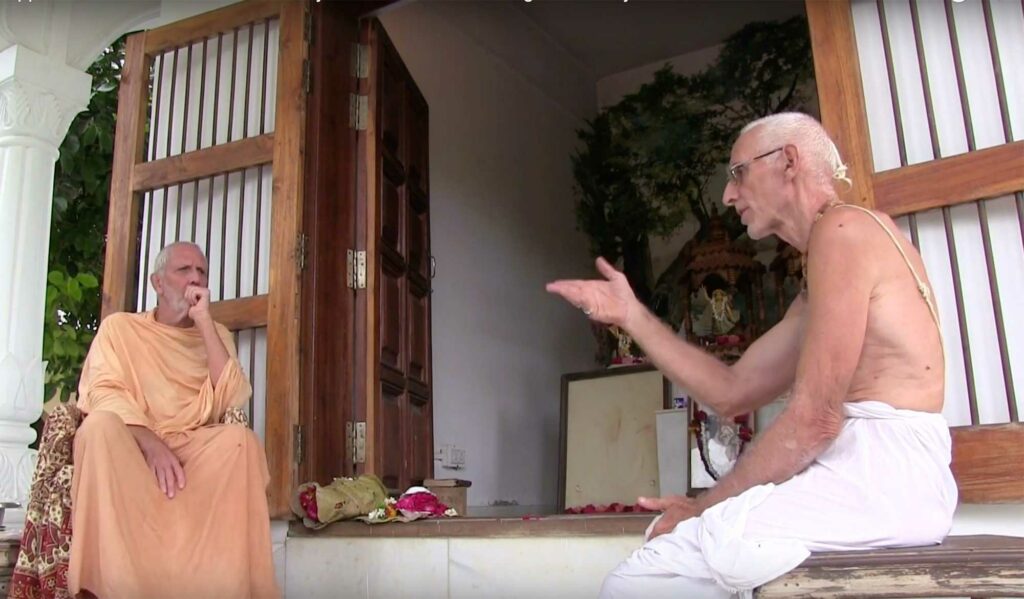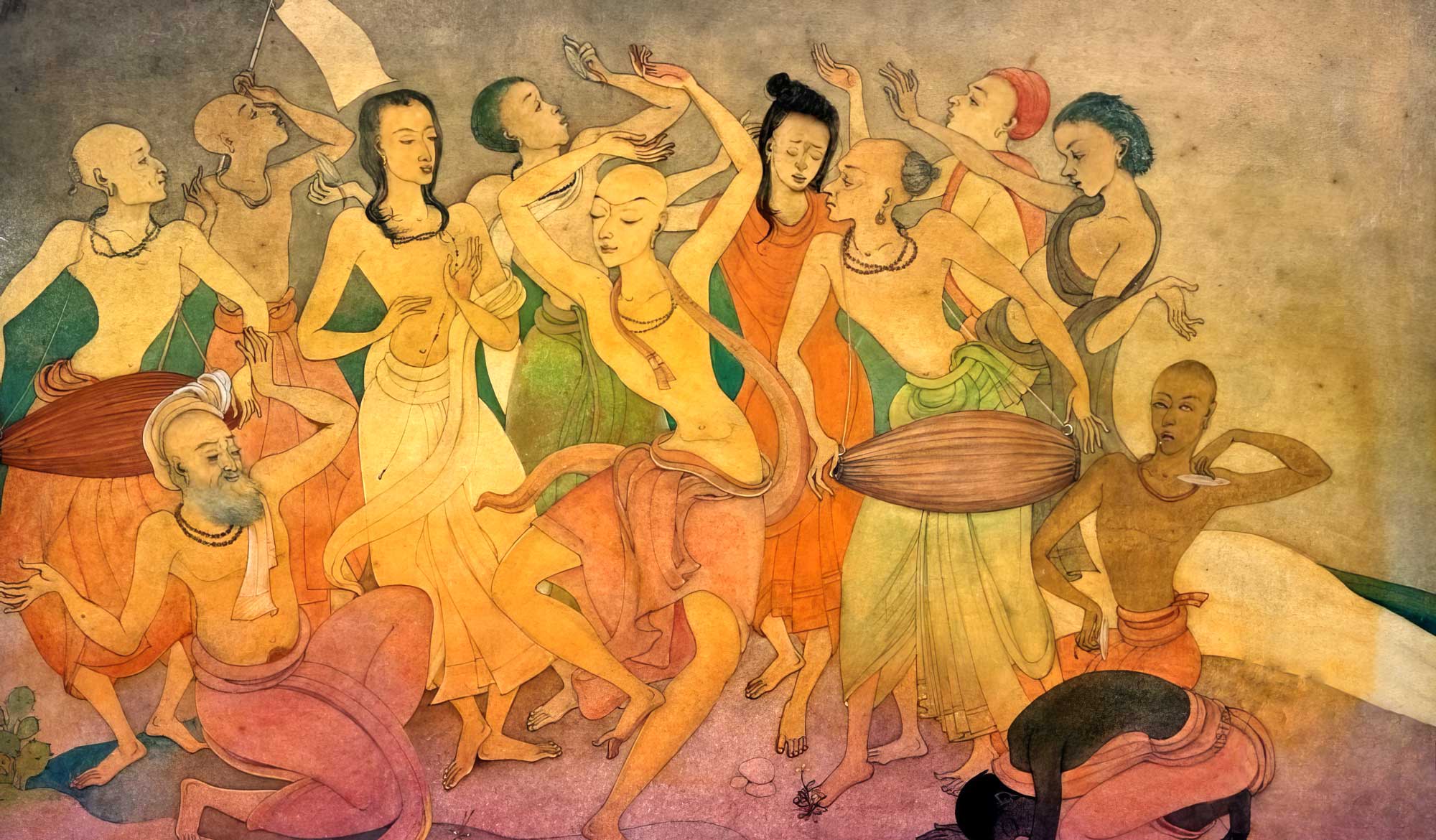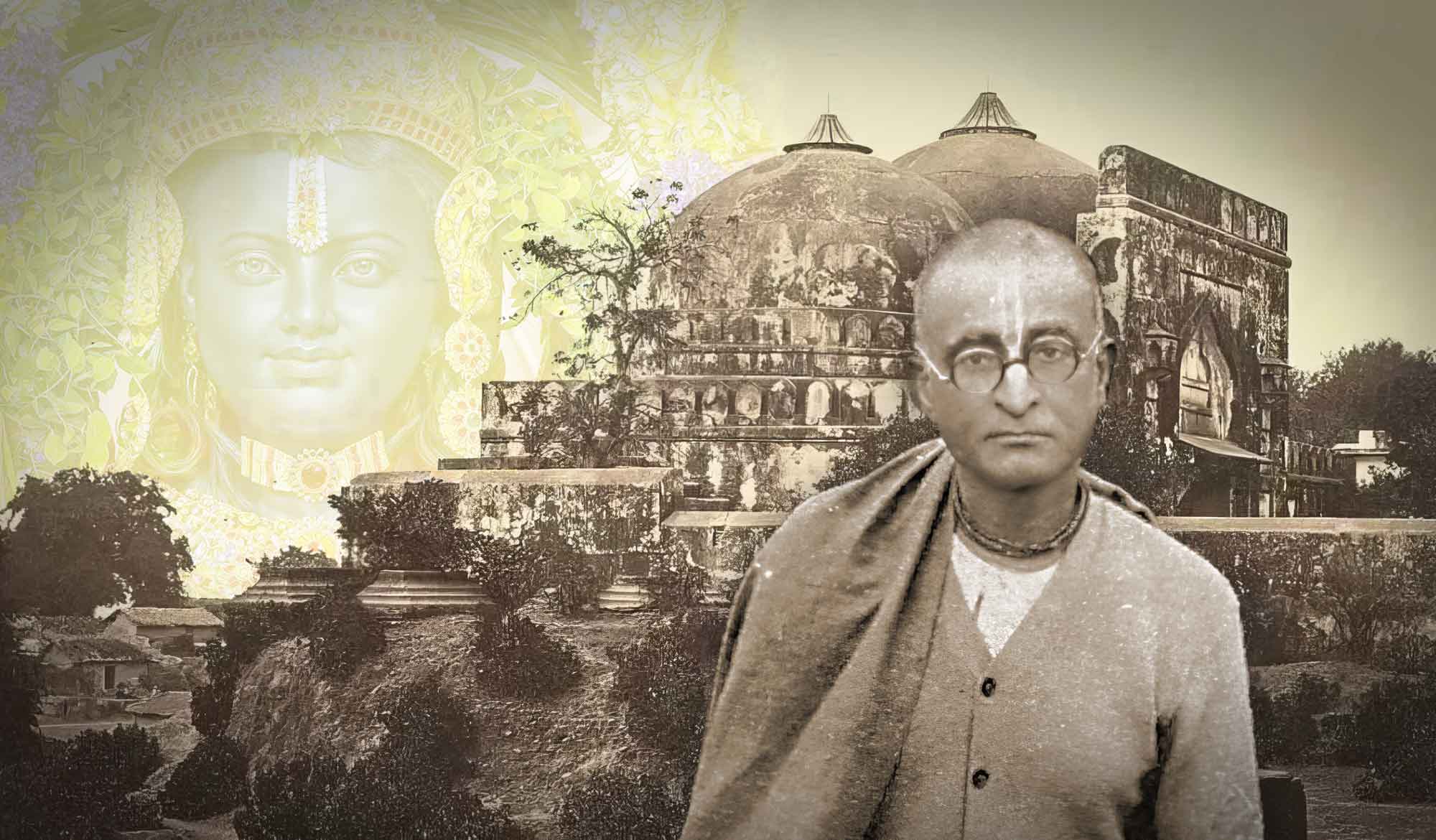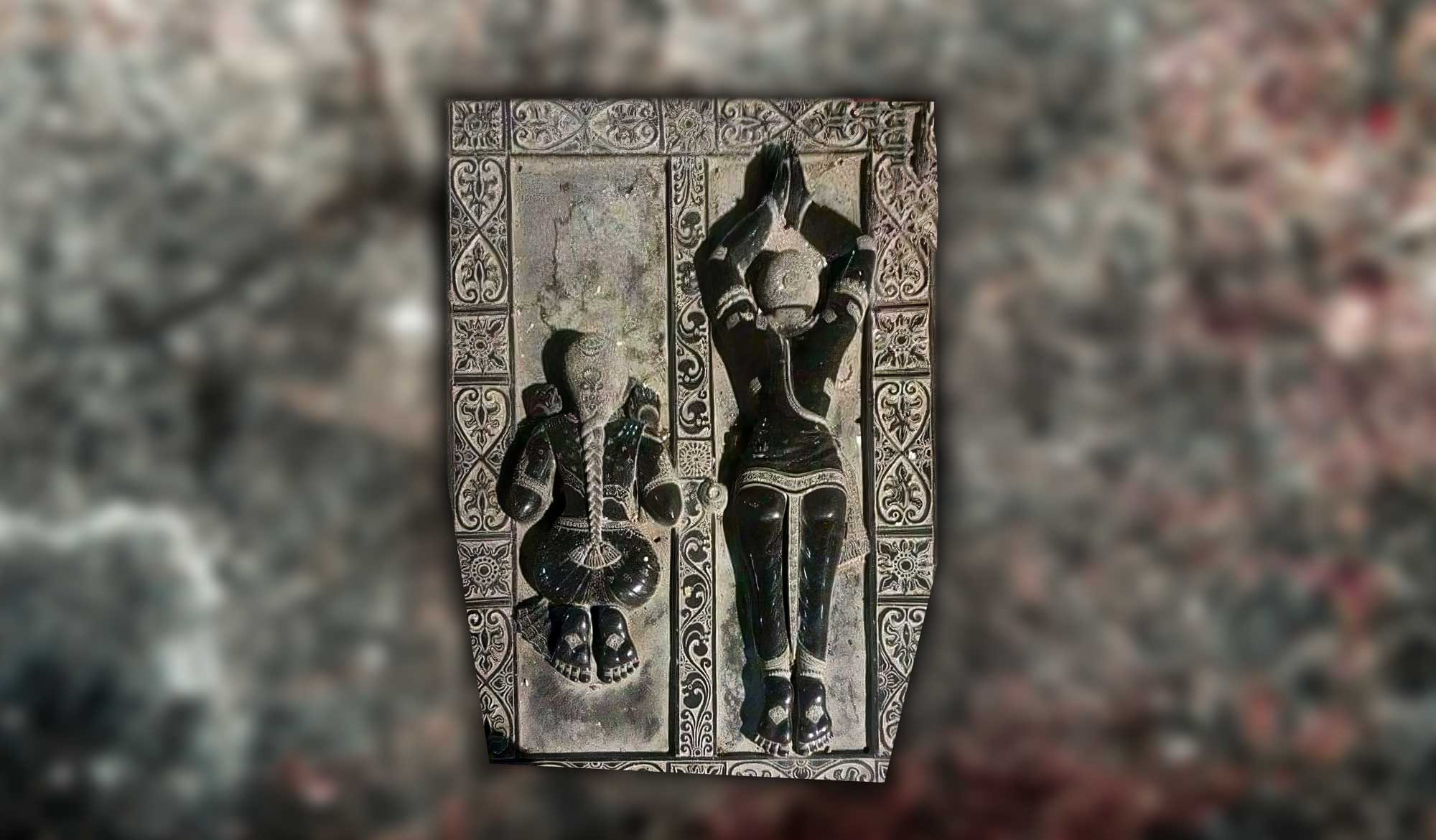Overview
In this article, Swami B.V. Giri describes in detail the characteristics of the three types of offenders to Śrī Guru - the guru-tyāgī, guru-bhogī and guru-drohī, and cites the previous ācāryas in explaining the serious offence of guru-avajñā, disobeying the order of the spiritual master.
Most devotees are familiar with the different types of gurus described in śāstra, but what many devotees are unaware of is that it also discusses different types of disciples – in particular, the sevakādhamas, or fallen disciples.
alir bāṇo jyotiṣakaḥ stabdhībhūtaḥ kimekakaṅ
preṣita-preṣakaś caiva ṣaḍ ete sevakādhamāḥ
“The six fallen servitors are the ‘bee,’ the ‘arrow,’, the ‘astrologer’ the dullard, the one who cannot do anything on his own, and the one who delegates his service to others.”
The first one described is ali or the bee-like disciple. Such a person buzzes around the guru for a while, and just as a bee extracts pollen from a flower and flies away, this fickle-minded disciple extracts whatever he can from the guru then rejects him and goes elsewhere to extract more from others. The bāṇa, or arrow-like disciple, causes pain to the heart of his guru by his words and deeds and is continuously disobedient. An arrow pierces and once release never returns – similarly, the arrow-like devotee pierces the guru’s heart and when asked to do service, he disappears. The jyotiṣaka, or astrologer devotee, always procrastinates and waits for an ‘auspicious moment’ (ie. when it suits him) to offer some service. Stabdhibhūta refers to the disciple who is lethargic and dull. When asked to do service, he drags his feet because he is lazy and unintelligent. Kimekaka literally means ‘what? Alone?’ and describes a disciple who would rather see someone else expend their time and energy serving the guru and therefore says, “So many others are here! Why can’t they do this service? Why must I do it alone?” Finally there is the disciple who is preṣita-preṣaka, or one who ‘passes the buck.’ He considers himself to be so busy or important that he delegates somebody else to do the service intended for him.
All these six kinds of ‘disciples’ can be placed into three categories – guru-tyāgī, guru-bhogī or guru–drohī.
THE GURU-TYĀGĪ
The word ‘tyāga’ means to reject, thus a guru–tyāgī is one who rejects the guru and his teachings. We see many examples of this in spiritual institutions. Someone takes dīkṣā from a guru and then later, for some reason or another, decides to totally abandon that guru and his instructions and go elsewhere. Of course, if a so-called guru is fallen and has gone against the teachings of his own spiritual master, then śāstra dictates that he is fit to be rejected. The term guru–tyāgī, however, refers to an errant disciple who rejects a genuine guru.
THE GURU-BHOGĪ
‘Bhoga ‘means to enjoy or exploit, thus a guru–bhogī is one who exploits his guru, or enjoys the facilities of the guru. A guru–bhogī uses his guru’s good name in order to gain recognition and prestige, or he may also usurp the guru’s mission after his departure. The guru–bhogī may perform some rudimentary ‘service’ so that he is not seen as lazy, but in reality, his activities mostly revolve around trying to put others down and surpass their service, Yet sometimes the guru-bhogī cannot even muster the energy to do that. Instead, he spends his days in the comfort zone of the guru’s āśrama or temple, eating, sleeping and living off the cheap praise of others. On the Vyāsa Pūjā day of his guru, he can speak eloquently about how his guru’s external mission is all-in-all, castigate those outside the mission who disagree with him, quote many ślokas, perform an extravagant pūjā, offer an abundance of flowers, and compose sweet Sanskrit poetry. None of these activities however are actually meant for the glorification of his spiritual master – rather, it is all veiled self-aggrandisement or meant for propagating society consciousness. The guru-bhogī thinks that the more he tows the institutional line, the more people will join, and the more he can engage them in his ‘service’.
We see that in order to enjoy the guru’s facilities, a guru–bhogī may sometimes become fearful and expel long-serving godbrothers and godsisters from their guru’s mission when he deems them to be a threat to his ascending the ‘corporate ladder.’ Thus he is free to assume a position of leadership, accept the garb of a renunciant (yati-veśa) or even sit on the seat of the guru himself.
Śrīla Śrīdhara Deva Gosvāmī Mahārāja describes guru-bhoga as ‘a very subtle thing’ –
“To support exploitation by sham devotion – a very subtle thing. We should sing the glories of the Vaiṣṇava and that is real life, but to misuse that for one’s own mundane purpose, that is not devotion. That is a plea to establish one’s own self. That should be avoided. Generally, here in India, they are known as guru-bhogī. Guru-bhogī – who wants to enjoy and exploit the name of guru and Vaiṣṇava to establish one’s own self. That is guru exploitationist, Vaiṣṇava exploitationist. It is exploitation in the form of praise of the Vaiṣṇava and guru. That is not devotion – that is aparādha.”
THE GURU-DROHĪ
The word ‘droha’ means to betray, therefore a guru–drohī is one who betrays the guru. One betrays the guru by willingly rejecting his instructions and regarding oneself as more intelligent than him. Deep down, the guru-drohī distrusts everyone, including his own guru, thinking that his own intelligence alone excels everyone else’s. The guru-drohī has a Machiavellian personality and doesn’t think twice about manipulating others for what he considers the “greater good.”
Ultimately, the guru–drohī considers the guru to be a fallible jīva who is capable of making mistakes, thus the guru-drohī is guilty of the third offence to the Holy Name, guru-avajña, or disobeying the instructions of Śrī Guru and thinking of him as an ordinary living entity. Thus he makes ludicrous statements such as, “My guru doesn’t know” or “I actually know what my guru really wants” etc. Although he rightfully states that the guru is not omniscient, he himself conveniently develops the quality of omniscience by claiming to understand the mind of the guru!
The guru–drohī is similar to the guru–tyāgī, except that the guru–tyāgī openly rejects his guru. However, the guru–drohī sometimes cannot discern his own anarthas and thinks that he actually has some guru-bhakti and may even perform some service. Yet he ‘cherry-picks’ which instructions of the guru he wishes to follow according to his own whims. This especially happens if he is a godbrother-disciple (a godbrother who has taken second initiation or sannyāsa from the guru who makes an external show of fidelity to him). However, even a direct disciple can be guilty of such an offence.
THE MOST DANGEROUS OFFENCE
Factually the guru-tyāgī, guru-bhogī and guru–drohī are all guilty of guru-avajñā. The word avajñā is generally translated as neglect, indifference, contempt, and disregard. Avajñā is a Sanskrit compound derived from the prefix ava (‘to depreciate’) and jñā (‘one who knows’). It can also be divided into ava (‘to depreciate’) and ajñā (order). Thus, guru–avajñā means to disregard the position of Śrī Guru, or to be indifferent or neglectful towards his instructions.
When asked what was the most dangerous of all the ten offences to hari–nāma, Śrīla Bhaktisiddhānta Sarasvatī Ṭhākura replied:
“To consider Śrīla Gurudeva to be an ordinary human being is the most deadly offence, the most severe nāma–aparādha. By maintaining a conception of him as a mere mortal, one cannot attain auspiciousness even in billions of births. A person with such a mundane conception of the guru will encounter various types of obstacles in bhakti and will be in danger of drowning in the ocean of material desires. Besides the lotus feet of Śrī Guru, nothing can save us from the clutches of harmful association. The jīva is unable to surrender himself at the lotus feet of Śrī Gurudeva only because he considers Śrī Gurudeva to be an ordinary human being.”
If we carefully analyse this statement, we can understand how guru–avajñā is the greatest threat to our spiritual life. The famous verse of Śrīla Dāsa Gosvāmī explains the unique gifts Śrī Guru has bestowed upon his disciple:
nāma-śreṣṭhaṁ manum api śacī-putram atra svarūpaṁ
rūpaṁ tasyāgrajam uru-purīṁ māthurīṁ goṣṭha-vāṭīm
rādha-kuṇḍaṁ giri-varam aho rādhikā-mādhavāśāṁ
prāpto yasya prathita-kṛpayā śrī-guruṁ taṁ nato ’smi
“I bow to the lotus feet of my spiritual master, by whose mercy I have obtained the supreme Name of Kṛṣṇa, the service of the son of Śacī Mātā, the association of Svarūpa Dāmodara, Rūpa Gosvāmī and his elder brother, Sanātana Gosvāmī, the Supreme Abode of Mathurā, the blissful abode of Vṛndāvana, the divine Rādhā-kuṇḍa, the best of hills (Govardhana) and the desire within my heart for loving service to Rādhā and Kṛṣṇa.”
If we disregard and offend the guru, how can we possibly achieve any of these transcendental gems that he has give us access to? At the very beginning of this śloka, Raghunātha Dāsa Gosvāmī mentions nāma-śreṣṭha, the supreme Name of Kṛṣṇa. When we offend the Name, especially by neglecting the instructions of that personality who has awarded us the Name, then our prospect of rendering service to Gaura-Rādhā-Govinda is completely lost, yet we continue to live under the illusion that we are serving and pleasing Śrī Guru.
THE TWO VISIONS OF ŚRĪ GURU
In Chapter 6 of Vaiṣṇava Siddhānta Mālā, Śrīla Bhaktivinoda Ṭhākura gives the following explanation of guru-avajñā:
“The dīkṣā-guru and the śikṣā-guru are the two types of spiritual masters. One must believe in the words of the guru and consider him to be a specific manifestation of Kṛṣṇa (kṛṣṇa-prakāśa), or understand that he is an eternally beloved transcendental principle belonging to Kṛṣṇa (nitya-preṣṭha śuddha-tattva).”
The first aspect of guru mentioned here (kṛṣṇa-prakāśa) specifically applies to the sādhaka seeing the guru through the lens of vaidhi-bhakti. Considering the guru as kṛṣṇa–prakāśa is also stated by Śrīla Viśvanātha Cakravartī Ṭhākura in the seventh verse of his Guruvaṣṭaka where describes the guru as sakṣad–hari – non-different from Hari Himself. This is also confirmed by Śrī Kṛṣṇa:
ācāryaṁ māṁ vijānīyān nāvamanyeta karhicit
na martya-buddhyāsūyeta sarva-devamayo guruḥ
“One should know the ācārya as Myself and never disrespect him in any way. One should not envy him, thinking him an ordinary man, for he is the representative of all the demigods.” (Śrīmad Bhāgavatam 11.17.27)
While commenting on this śloka, Śrīla Sanātana Gosvāmī explains that the word asūyā (envy) refers to finding fault with the guru and his instructions. This is also in accordance with the Amāra-kośa dictionary which defines asūyā as “a tendency to find fault where there is only virtue.”
The other aspect of guru mentioned by Ṭhākura Bhaktivinoda is nitya-preṣṭha śuddha-tattva, an eternally beloved transcendental principle belonging to Kṛṣṇa. This applies to the disciple on the path of rāga who sees Śrī Guru as an eternal associate of Kṛṣna in a particular rasa. More specifically, this applies when the disciple cultivates the mellows of śṛṅgara-rasa, and sees Śrī Guru under the shelter of Lalitā Devī and engaged in the divine service of Śrīmatī Rādhārāṇī.
One can only view Śrī Guru as kṛṣna-prakāśa or as nitya-preṣṭha śuddha-tattva. There is no third option except for guru–avajñā – considering him to be a limited jīvātmā. The Padma Purāṇa warns us to avoid such a mentality:
arcā-viṣṇor śilādhir guruṣu naramatir vaiṣṇave jāti-buddhi
viṣṇor vā vaiṣṇavānāṁ kali-mala-mathane pāda-tīrthe’mbu-buddhiḥ
siddhe tan nāma-mantre kali-kaluṣa hare śabda-sāmānya-buddhiḥ
śrīśe sarveśvareśa tad itara sama dhīr yasya vā nārakī saḥ
“One who considers the Deity of Viṣṇu to be merely stone, who thinks the guru to be an ordinary man, who gauges a Vaiṣṇava according to the community he was born in, who regards the caraṇāmṛta of Viṣṇu or the Vaiṣnavas, which removes the contamination of the age of Kali, to be ordinary water, who considers the perfect mantra of Bhagavān (which destroys the pollution of Kali-yuga) to be an ordinary sound, who thinks that the form of Śrīpati, the Lord of Lakṣmī, the Supreme Controller, and the Devas are equal—such a person is a resident of the hellish regions!”
If our polluted mundane consciousness forces us to consider Śrī Guru as a fallible jīva prone to making mistakes, if we do not consider him to be the pure vessel of prema–bhakti capable of delivering us from saṁsāra, or if we make the offence of maryādā–vyatikrama (impertinently thinking we know better than our guru), then we are doomed to make no advancement on the path of bhakti. Rather we will spiral downwards.
In this regard Śrīla Purī Gosvāmī Mahārāja writes:
“A disciple’s qualifications immediately disappear as soon as he starts seeing even the slightest insufficiency in his guru’s appearance, virtues, learning, intelligence, eloquence, capabilities, caste, spiritual realisation, or popular acceptance, or as soon as he feels any doubt about any of these.” (Śrīla Purī Gosvāmī, Guru – The Universal Teacher, Chapter 5)
The Hari-bhakti-vilasa (4.353), quoting the Vāmana-Kalpa states, yo mantraḥ sa guruḥ sākṣāt (‘one’s mantra should be considered to be non-different from the guru himself.’). However, by the crippling influence of guru–avajñā, one’s mantras become ineffective.
“Since it is the Lord, the supreme object of worship, who is personally present as the spiritual master, if one has the deranged idea to think of him as an ordinary mortal, then whatever he has heard from him – whether it is the mantras received at the time of initiation or instructions in the scripture and devotional practice – ceases to have any effect.” (Śrīla Purī Gosvāmī, Guru – The Universal Teacher, Chapter 10)
THE FATE OF OFFENDERS TO ŚRĪ GURU
From the above statements, we can understand the severity of the offence of guru-avajñā. What is the destination of the guru-tyāgī, guru-bhogī and guru–drohī? This is explained by Śrīla Sanātana Gosvāmī in Hari -bhakti-vilāsa (4.363-365) quoting the Brahma-vaivarta Purāṇa as follows:
upadeṣṭāram āmnāyāgataṁ pariharanti ye
tān mṛtān api kravyādāḥ kṛtaghnān nopabhuñjate
“One who rejects a genuine guru is ungrateful. When he dies, even carnivorous animals will not devour his corpse.”
bodhaḥ ṣitas tena daurātmyaṁ prakaṭī kṛtam
gurur yena parityaktas tena tyaktaḥ purā hariḥ
“One pollutes his own intelligence and displays intense weakness when he rejects his own guru. Such a person has already rejected Lord Hari.”
pratipadya guruṁ yas tu mohād vipratipadyate
sa kalpa-koṭiṁ narake pacyate puruṣādhamaḥ
“One who has accepted a guru, but due to bewilderment rejects him, is considered to be the lowest amongst men. He will be cooked in hell for millions of kalpas.”
Furthermore, the Skanda Purāṇa describes the fate of the guru-bhogī and guru–drohī:
ekākṣaraparadātāraṁ yo gurur naiva manyate
śvana-yoniśaṁ gatvā cāṇḍaleṣuv api jāyate
“One who does not respect or show honour to the guru takes innumerable births in the wombs of dogs and other low-born species, and ultimately takes birth in the womb of a cāṇḍala.”
manda-bhāgya hy aśaktyāś ca ye janā nānumanvate
guru-sevāsu-vimukhāḥ pacyante narakeśucau
“The unfortunate, the weak, and those who have turned their faces away from the service of the guru and do not believe in his teachings, and must burn in a most hellish condition.”
guruṁ tvaṁ kṛtya huṁ-kṛtya guru-sānni-dhyabhāṣaṇaḥ
araṇye nirjala deśe saṁbhaved brahma-rākṣasaḥ
“One who speaks disrespectfully to the guru or argues with him takes birth as a demon in a jungle or in an area devoid of water.”
So what should we actually gather from these colourful and strongly-worded ślokas? Such verses basically indicate that when one rejects Śrī Guru or finds some so-called fault in his character, teachings or instructions, one’s mentality begins to devolve further and further. What may begin as a seemingly insignificant and small criticism of the guru eventually gives rise to the perception of seeing all spiritual activities and personalities as faulty and mundane. In other words, if we consider the guru and his words to be defective and open to analysis based upon our own mundane intellect and experience, then everything connected to transcendence is also open to our limited interpretation. With such a mindset one cannot see the hand of Kṛṣṇa in anything. Thus, the so-called disciple’s degraded consciousness is hurled into a hellish condition lifetime after lifetime.
It thus behooves a serious sādhaka to aspire to become a guru-sevī (a sincere servant of Śrī Guru) and to constantly be on guard so that they never commit the offence of guru-avajñā, spiraling down into the dark chasm of guru-tyāga, guru-bhoga or guru-droha.
Related Articles
- 📖 Prabhupāda Vijaya (Book)
- 📖 The Authorized Sri Caitanya Saraswata Parampara (Book)
- Guru-Bruva (The Pseudo-Guru) by Śrīla Bhaktisiddhānta Sarasvatī Ṭhākura
- Guru-tyāgī, Guru-bhogī and Guru-drohī by Swami B.V. Giri
- Who is Qualified to Succeed the Ācārya? by Śrīla Bhakti Rakṣaka Śrīdhara Mahārāja
- Deviations of the Ācārya by Śrīla Bhakti Rakṣaka Śrīdhara Mahārāja
- Śrīla Prabhupāda – in a Class by Himself? by Śrīla Bhakti Gaurava Narasiṅgha Mahārāja
- Big Fish in a Small Pond by Śrīla Bhakti Gaurava Narasiṅgha Mahārāja
- Guru-pādāśraya by Śrīla Bhakti Gaurava Narasiṅgha Mahārāja
- Can the Guru Make Mistakes? by Śrīla Bhakti Gaurava Narasiṅgha Mahārāja
- Change, Change, Change! by Śrīla Bhakti Gaurava Narasiṅgha Mahārāja
- Śrīla Prabhupāda – A Second Generation Devotee’s Perspective by Gaura Gopāla Dāsa
- The Change Disease by Gaura Gopāla Dāsa
Further Reading
Prema Dhāma Deva Stotram with the Narasiṅgha Sevaka Commentary – Verses 61-65
In verses 61 to 65 of 'Prema Dhāma Deva Stotram', Śrīla Śrīdhara Mahārāja narrates the pastime of Śrī Caitanya at Caṭaka Parvata In Purī and explains how the scriptures produced by Brahmā and Śiva are ultimately searching for the personality of Mahāprabhu who is merciful too all jīvas, no matter what their social position.
Prabhupāda Śrīla Sarasvatī Ṭhākura’s Visit to Ayodhyā
With the forthcoming observance of Śrī Rāma Navamī, we present 'Prabhupāda Śrīla Sarasvatī Ṭhākura’s Visit to Ayodhyā' written by Śrīla Bhaktisiddhānta Sarasvatī Ṭhākura Prabhupāda from The Gaudīyā magazine, Vol 3. Issue 21/ In December 1924, after visiting Benares and Prāyāga, Sarasvatī Ṭhākura visited the birth-site of Śrī Rāmācandra in Ayodhyā.
Śaraṇāgati – The Only Path to Auspiciousness
In this article, 'Śaraṇāgati - The Only Path to Auspiciousness', Dhīra Lalitā Dāsī analyses the process of śaraṇāgati (surrender) beginning with śraddhā (faith). She also discusses the role of śāstra and the Vaiṣṇava in connection with surrender.
Ātma Samīkṣā – The Value of Introspection
In this article, "Ātma Samīkṣā – The Value of Introspection" Kalki Dāsa highlights the importance of introspection in the life of a devotee and especially in relation to the worldly environment that surrounds us. He also explains how transcendental sound influences our capacity to introspect.
Prema Dhāma Deva Stotram with the Narasiṅgha Sevaka Commentary – Verses 61-65
In verses 61 to 65 of 'Prema Dhāma Deva Stotram', Śrīla Śrīdhara Mahārāja narrates the pastime of Śrī Caitanya at Caṭaka Parvata In Purī and explains how the scriptures produced by Brahmā and Śiva are ultimately searching for the personality of Mahāprabhu who is merciful too all jīvas, no matter what their social position.
Prabhupāda Śrīla Sarasvatī Ṭhākura’s Visit to Ayodhyā
With the forthcoming observance of Śrī Rāma Navamī, we present 'Prabhupāda Śrīla Sarasvatī Ṭhākura’s Visit to Ayodhyā' written by Śrīla Bhaktisiddhānta Sarasvatī Ṭhākura Prabhupāda from The Gaudīyā magazine, Vol 3. Issue 21/ In December 1924, after visiting Benares and Prāyāga, Sarasvatī Ṭhākura visited the birth-site of Śrī Rāmācandra in Ayodhyā.
Śaraṇāgati – The Only Path to Auspiciousness
In this article, 'Śaraṇāgati - The Only Path to Auspiciousness', Dhīra Lalitā Dāsī analyses the process of śaraṇāgati (surrender) beginning with śraddhā (faith). She also discusses the role of śāstra and the Vaiṣṇava in connection with surrender.
Ātma Samīkṣā – The Value of Introspection
In this article, "Ātma Samīkṣā – The Value of Introspection" Kalki Dāsa highlights the importance of introspection in the life of a devotee and especially in relation to the worldly environment that surrounds us. He also explains how transcendental sound influences our capacity to introspect.


